**Chart 1: Price-to-Book Ratio**
The first chart showcases the Price-to-Book Ratio over a ten-year span. The Price-to-Book Ratio is a fundamental valuation metric used by investors to gauge whether a stock is undervalued or overvalued based on its book value. In this chart, we see a steady increase in the Price-to-Book Ratio, indicating that the market has been willing to pay a higher premium for each dollar of book value. This suggests that investors are becoming more optimistic about the future performance and growth prospects of the overall market.
The gradual uptrend in the Price-to-Book Ratio could be attributed to several factors. One possible reason is the low-interest-rate environment, which has led to investors seeking higher returns in the stock market. Additionally, companies have been reporting strong earnings and growth, boosting investor sentiment and pushing up valuations. However, a continuously rising Price-to-Book Ratio could be an indication of a market bubble, as valuations become detached from the underlying fundamentals of the companies.
As a prudent investor, it is essential to consider the Price-to-Book Ratio when evaluating investment opportunities. A high Price-to-Book Ratio may suggest that a stock is overvalued, while a low ratio could indicate that it is undervalued. By analyzing this chart and monitoring changes in the Price-to-Book Ratio, investors can make more informed decisions about their investment portfolios and assess the overall market sentiment.
**Chart 2: Sentiment Index**
The second chart displays the Sentiment Index, which measures the overall market sentiment based on surveys, investor sentiment indicators, and other data points. A high level on the Sentiment Index indicates that investors are excessively optimistic, while a low level suggests excessive pessimism. In this chart, we observe a sharp increase in the Sentiment Index, reaching its peak, followed by a gradual decline.
The surge in the Sentiment Index to its peak suggests that market participants have been overwhelmingly bullish, expecting continued market growth and economic prosperity. However, extreme levels of optimism often precede market corrections or downturns, as they can lead to asset bubbles and irrational exuberance. The subsequent decline in the Sentiment Index may indicate a shift in sentiment towards more caution or even fear among investors.
Monitoring the Sentiment Index is crucial for investors to assess market psychology and potential market reversals. When the Sentiment Index reaches extreme levels, it may serve as a contrarian indicator, signaling a possible market correction or downturn. By incorporating sentiment analysis into their investment strategy, investors can better navigate market cycles and make more informed decisions based on prevailing market sentiment.
**Chart 3: Price-to-Earnings Ratio**
The third chart illustrates the Price-to-Earnings (P/E) Ratio trend over the past decade. The P/E Ratio is a widely used valuation metric that compares a company’s stock price to its earnings per share. A high P/E Ratio may indicate overvaluation, while a low P/E Ratio could signal undervaluation. In this chart, we observe a consistent rise in the P/E Ratio, reaching elevated levels.
The upward trend in the P/E Ratio reflects the market’s willingness to pay a higher price for each dollar of earnings generated by companies. This may be driven by expectations of robust earnings growth, positive economic outlook, or low interest rates. However, a high P/E Ratio can also imply that investors are extrapolating strong earnings growth into the future, raising concerns about valuation sustainability and potential market corrections.
Investors should consider the P/E Ratio when evaluating individual stocks or the overall market. A thorough analysis of the P/E Ratio can help investors identify overvalued or undervalued opportunities and make informed investment decisions. By monitoring changes in the P/E Ratio and comparing them to historical averages and market conditions, investors can gain valuable insights into market valuations and adjust their investment strategies accordingly.

